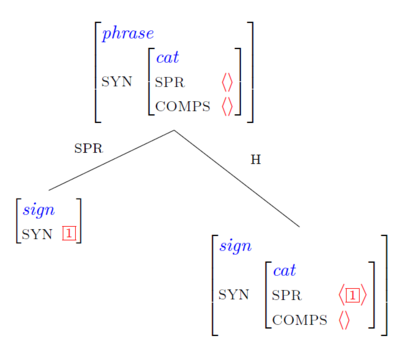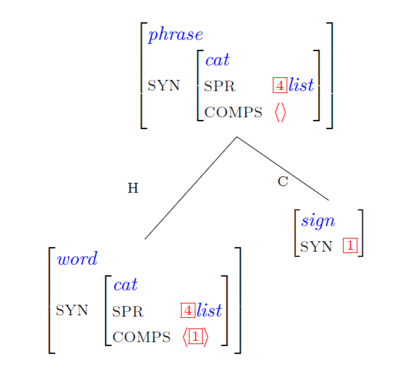Syntax 1 Wiki: Week 4
Looking under the hood
Exercise
Go to the Online Grammar and do the following:
- Type "snores" into the Sentence textbox and press the "Parse" button or RETURN on your keyboard.
- Click once on the top node of the tree.
- Inspect the result and try to understand as much as possible.
Now click on the boxed "0" after AGR.
- Inspect the result and try to understand as much as possible.
Finally, click on the boxed number below the NP in the SPR list.
- Again, inspect the result and try to understand as much as possible.
Click on the new boxed "0" after the AGR that appears.
- Now there are two boxed "0"s on the screen. What seems to be their function?
Exercise
Go to the Online Grammar and do the following:
- Parse the sentence Lilly dances".
- Open the S node and the V node. Don't open any numbered boxes for now.
- Compare the two feature structures.
- For every feature (= attribute), compare the values of mother and daughter.
- Now open the N node, leaving its numbered boxes alone again.
- Compare the three feature structures. What relationships do you detect? Do the self-test exercises below.
Self-test exercises
(1) The part of speech features of the mother are also the part of speech features of
Check your answer
the verb.
(2) The verb is looking for ______ complements.
Check your answer
no
(3) The sentence is looking for ______ complement(s).
Check your answer
no
(4) The verb is looking for ______ specifier(s).
Check your answer
one
(5) If the verb requires a specifier, then it selects a specifier of part of speech ________.
Check your answer
NP
(6) The sentence is looking for ______ specifiers.
Check your answer
no
(7) Formulate the relationship between the valences of S and V, and the relationship between the NP daughter and the V daughter.
Check your answer
A. The verb is complement-empty and selects one NP-specifier.
B. The NP acts as the verb's specifier.
C. As the verb's specifier requirement has now been satisfied, its mother S has an empty SPR list (as well as an empty COMPS list).
Head-Specifier Phrases
We can combine all the observations above into a Phrase Structure Rule. In short form, the rule can be formulated as follows:
(1) XP -> Specifier X
We call this kind of phrase a head-specifier phrase.
Instead of formulating the full-fledged PS rule, we look directly at the local tree that the rule licenses:
In words: A head-specifier phrase can be formed by combining a sign [= the head daughter] with a second sign [= the specifier daughter] whose syntactic category can be unified with the syntactic category on the word’s SPR list. The mother and its head daughter are both COMPS-saturated (= have empty COMPS lists).
Comparing the tree in the online grammar with the tree above (the rule), you will notice that they aren't completely identical.
(2) What does the rule contain that is missing from the tree?
Check your answer
The rule marks the righthand daughter as the head (= H) and the lefthand daughter as a specifier (= SPR).
(3) What does the tree contain that is missing from the rule?
Check your answer
The tree contains the information that the mother node and the head have the same part of speech features.
The Head Feature Principle
Let us deal with the second difference first. It will turn out that this will also take care of the first one.
Head-specifier phrases are not the only kind of phrase. We will soon see others. All phrases have one thing in common, however:
The Head Feature Principle (HFP) The part of speech features of a phrase are also the part of speech features of its head daughter.
Formally, this is expressed as follows:
The Head Feature Principle (formal)
The formal version of the head feature principle is a constraint. Constraints are all of the form "If a feature structure F has a property A, then F is well formed only if F also has property B." The double arrow expresses the if-then.
Consequently, the constraint above says: if a feature structure F is a phrase, then F is well formed only if F's value for POS is also the value of POS of F's head daughter.
With this, we are ready to return to (3) in the previous section. Remember that we wanted to take care of the fact that the head-specifier rule lacks the information of the identity of head features of mother and head daughter. This problem is now solved: since head-specifier phrases are phrases, they are well formed only if their POS features are identical to the POS features of their head daughter.
The difference between the online grammar and the head-specifier rule thus is explained as follows: the online grammar shows the sum of information contained in the head specifier rue and the head feature principle!
The effect of the head feature principle shown in the online grammar also takes care of the observation (2) in the previous section. You can always tell which daughter of a phrase is its head daughter: it is the daughter which shares the phrase's POS features.
Exercise
Go to the Online Grammar and do the following:
- Parse the string "a cat".
- Click on the three category nodes.
- Interpret what you see.
Head-Complement Phrases
Exercise
Go to the Online Grammar and do the following:
- Parse the string "likes lilly".
- Click on the three category nodes.
- Interpret what you see and answer the following questions.
(1) Which daughter is the head daughter of the head-complement phrase?
Check your answer
the lefthand daughter
(2) What is the valence relationship between the daughters of the head-complement phrase?
Check your answer
the head daughter selects the non-head daughter as a complement.
(3) How are the COMPS valences of a head-complement phrase and its head daughter related?
Check your answer
The head daughter selects a complement, which is realized as its sister in the tree.
The head-complement phrase is COMPS-saturated, since there are no further complements to be realized.
(4) How are the SPR valences of a head-complement phrase and its head daughter related?
Check your answer
They are identical. The head-complement phrase selects the same specifiers as its head daughter.
Exercise
Based on the properties of head-complement phrases just discovered, draw a schematic non-local tree for head-complement phrases in the same format as was done for head-specifier phrases above.
Here is the solution:
The Structure of Head-Complement Phrases

